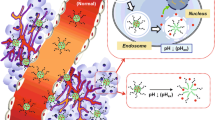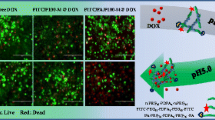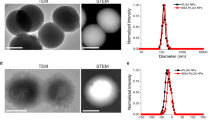Abstract
In this study, novel smart pH-sensitive nanoparticles of PLA-mPEG2000/TPGS3350-PHis-Folate for enhanced effect of chemotherapy are developed. Polyethylene glycol (PEG) is decorated on the surface of nanocarriers in order to prolong the circulation of nanoparticles in blood; the pH-sensitive material of poly(l-histidine) is utilized in nanoparticles for the intelligent purposes: under normal physiological pH, the targeting molecule of folate can be hidden into the layer of PEG in nanoparticles, which closes the active targeting function of nanoparticles; but in weak acid of tumor tissue, poly(l-histidine) is protonated to expose folate on the surface of nanoparticles, opening the active targeting function; next, nanoparticles are internalized by cells via folate receptor-mediated endocytosis; finally, poly(l-histidine) in endosome/lysosome begins to dissociate, leading to quick intracellular drug release. The features of the nanoparticles such as morphology, particle size, drug loading content, in vitro release and in vitro cytotoxicity are further investigated. Nanoparticles designed in this work have multiple functions such as active targeting, long circulation and easy internalization by cells simultaneously, and rapid intracellular drug release, which demonstrates huge potential to apply for the efficient treatment of cancer.









Similar content being viewed by others
References
Siegel RL, Miller KD, Jemal A (2016) Cancer statistics, 2016. CA Cancer J Clin 66(1):7–30
Schiller JH, Harrington D, Belani CP, Langer C, Sandler A, Krook J, Zhu JM, Johnson DH, Eastern G (2002) Cooperative oncology, comparison of four chemotherapy regimens for advanced non-small-cell lung cancer. N Engl J Med 346(2):92–98
Zitvogel L, Apetoh L, Ghiringhelli F, Kroemer G (2008) Immunological aspects of cancer chemotherapy. Nat Rev Immunol 8(1):59–73
Pelaz B, Alexiou C, Alvarez-Puebla RA, Alves F, Andrews AM, Ashraf S, Balogh LP, Ballerini L, Bestetti A, Brendel C (2017) Diverse applications of nanomedicine. ACS Nano 11(3):2313–2381
Sun T, Zhang YS, Pang B, Hyun DC, Yang M, Xia Y (2014) Engineered nanoparticles for drug delivery in cancer therapy. Angew Chem Int Ed 53(46):12320–12364
Blanco E, Shen H, Ferrari M (2015) Principles of nanoparticle design for overcoming biological barriers to drug delivery. Nat Biotechnol 33(9):941–951
Kamaly N, Yameen B, Wu J, Farokhzad OC (2016) Degradable controlled-release polymers and polymeric nanoparticles: mechanisms of controlling drug release. Chem Rev 116(4):2602–2663
Nicolas J, Mura S, Brambilla D, Mackiewicz N, Couvreur P (2013) Design, functionalization strategies and biomedical applications of targeted biodegradable/biocompatible polymer-based nanocarriers for drug delivery. Chem Soc Rev 42(3):1147–1235
Ulbrich K, Hola K, Subr V, Bakandritsos A, Tucek J, Zboril R (2016) Targeted drug delivery with polymers and magnetic nanoparticles: covalent and noncovalent approaches, release control, and clinical studies. Chem Rev 116(9):5338–5431
Dai Y, Xu C, Sun X, Chen X (2017) Nanoparticle design strategies for enhanced anticancer therapy by exploiting the tumour microenvironment. Chem Soc Rev 46(12):3830–3852
Stewart MP, Sharei A, Ding X, Sahay G, Langer R, Jensen KF (2016) In vitro and ex vivo strategies for intracellular delivery. Nature 538(7624):183–192
Bourzac K (2016) Cancer nanomedicine, reengineered After recent setbacks, researchers hope to find approaches more attuned to the complexities of cancer biology. Proc Natl Acad Sci USA 113(45):12600–12603
Shi J, Kantoff PW, Wooster R, Farokhzad OC (2017) Cancer nanomedicine: progress, challenges and opportunities. Nat Rev Cancer 17(1):20–37
Pozzi D, Colapicchioni V, Caracciolo G, Piovesana S, Capriotti AL, Palchetti S, De Grossi S, Riccioli A, Amenitsch H, Lagana A (2014) Effect of polyethyleneglycol (PEG) chain length on the bio-nano-interactions between PEGylated lipid nanoparticles and biological fluids: from nanostructure to uptake in cancer cells. Nanoscale 6(5):2782–2792
Du J, Lane LA, Nie S (2015) Stimuli-responsive nanoparticles for targeting the tumor microenvironment. J Control Release 219:205–214
Karimi M, Ghasemi A, Zangabad PS, Rahighi R, Basri SMM, Mirshekari H, Amiri M, Pishabad ZS, Aslani A, Bozorgomid M, Ghosh D, Beyzavi A, Vaseghi A, Aref AR, Haghani L, Bahrami S, Hamblin MR (2016) Smart micro/nanoparticles in stimulus-responsive drug/gene delivery systems. Chem Soc Rev 45(5):1457–1501
Mura S, Nicolas J, Couvreur P (2013) Stimuli-responsive nanocarriers for drug delivery. Nat Mater 12(11):991–1003
Hu J, Miura S, Na K, Bae YH (2013) pH-responsive and charge shielded cationic micelle of poly(L-histidine)-block-short branched PEI for acidic cancer treatment. J Control Release 172(1):69–76
Lee ES, Na K, Bae YH (2005) Super pH-sensitive multifunctional polymeric micelle. Nano Lett 5(2):325–329
Zhou Z, Badkas A, Stevenson M, Lee JY, Leung YK (2015) Herceptin conjugated PLGA-PHis-PEG pH sensitive nanoparticles for targeted and controlled drug delivery. Int J Pharm 487(1):81–90
Ko H, Son S, Jeon J, Thambi T, Kwon S, Chae YS, Young MK, Park JH (2016) Tumor microenvironment-specific nanoparticles activatable by stepwise transformation. J Control Release 234:68–78
Yang KN, Zhang CQ, Wang W, Wang PC, Zhou JP, Liang XJ (2014) pH-responsive mesoporous silica nanoparticles employed in controlled drug delivery systems for cancer treatment. Cancer Biol Med 11(1):34–43
Lu Y, Aimetti AA, Langer R, Gu Z (2016) Bioresponsive materials. Nat Rev Mater 2 16075:1–17
Alvarez-Lorenzo C, Concheiro A (2014) Smart drug delivery systems: from fundamentals to the clinic. Chem Commun 50(58):7743–7765
Lee ES, Gao Z, Bae YH (2008) Recent progress in tumor pH targeting nanotechnology. J Control Release 132(3):164–170
Li Z, Qiu L, Chen Q, Hao T, Qiao M, Zhao H, Zhang J, Hu H, Zhao X, Chen D, Mei L (2015) pH-sensitive nanoparticles of poly(L-histidine)-poly(lactide-co-glycolide)-tocopheryl polyethylene glycol succinate for anti-tumor drug delivery. Acta Biomater 11:137–150
Wu H, Zhu L, Torchilin VP (2013) pH-sensitive poly(histidine)-PEG/DSPE-PEG co-polymer micelles for cytosolic drug delivery. Biomaterials 34(4):1213–1222
Liu R, Li D, He B, Xu X, Sheng M, Lai Y, Wang G, Gu Z (2011) Anti-tumor drug delivery of pH-sensitive poly(ethylene glycol)-poly(L-histidine-)-poly(L-lactide) nanoparticles. J Control Release 152(1):49–56
Pan J, Feng SS (2008) Targeted delivery of paclitaxel using folate-decorated poly(lactide)-vitamin E TPGS nanoparticles. Biomaterials 29(17):2663–2672
Mi Y, Liu Y, Feng SS (2011) Formulation of docetaxel by folic acid-conjugated -α-tocopheryl polyethylene glycol succinate 2000 (vitamin E TPGS) micelles for targeted and synergistic chemotherapy. Biomaterials 32(16):4058–4066
Zhang Z, Mei L, Feng SS (2012) Vitamin E D-α-tocopheryl polyethylene glycol 1000 succinate-based nanomedicine. Nanomedicine 7(11):1645–1647
Pan J, Wan D, Bian Y, Guo Y, Jin F, Wang T, Gong J (2014) Reduction of nonspecific binding for cellular imaging using quantum dots conjugated with vitamin E. Aiche J 60(5):1591–1597
Lee ES, Shin HJ, Na K, Bae YH (2003) Poly(L-histidine)-PEG block copolymer micelles and pH-induced destabilization. J Control Release 90(3):363–374
Liu R, He B, Li D, Lai Y, Tang JZ, Gu Z (2012) Synthesis and characterization of poly(ethylene glycol)-b-poly(L-histidine)-b-poly(L-lactide) with pH-sensitivity. Polymer 53(7):1473–1482
Pan J, Liu Y, Feng SS (2010) Multifunctional nanoparticles of biodegradable copolymer blend for cancer diagnosis and treatment. Nanomedicine 5(3):347–360
Philipsen HJA (2004) Determination of chemical composition distributions in synthetic polymers. J Chromatogr A 1037(1):329–350
Pan J, Wang Y, Feng SS (2008) Formulation, characterization, and in vitro evaluation of quantum dots loaded in poly(lactide)-vitamin E TPGS nanoparticles for cellular and molecular imaging. Biotechnol Bioeng 101(3):622–633
Radovic-Moreno AF, Lu TK, Puscasu VA, Yoon CJ, Langer R, Farokhzad OC (2012) Surface charge-switching polymeric nanoparticles for bacterial cell wall-targeted delivery of antibiotics. ACS Nano 6(5):4279–4287
Lee ES, Oh KT, Kim D, Youn YS, Bae YH (2007) Tumor pH-responsive flower-like micelles of poly (L-lactic acid)-b-poly (ethylene glycol)-b-poly (L-histidine). J Control Release 123(1):19–26
Acknowledgements
This research work was financially supported by the National Natural Science Foundation of China (No. 21506161, 21646010 and 21476172) and Open Funds from the key laboratory of biomedical materials in Tianjin (No. 1634-1).
Author information
Authors and Affiliations
Corresponding authors
Ethics declarations
Conflict of interest
The authors declare that they have no conflict of interest.
Rights and permissions
About this article
Cite this article
Pan, J., Lei, S., Chang, L. et al. Smart pH-responsive nanoparticles in a model tumor microenvironment for enhanced cellular uptake. J Mater Sci 54, 1692–1702 (2019). https://doi.org/10.1007/s10853-018-2931-y
Received:
Accepted:
Published:
Issue Date:
DOI: https://doi.org/10.1007/s10853-018-2931-y




